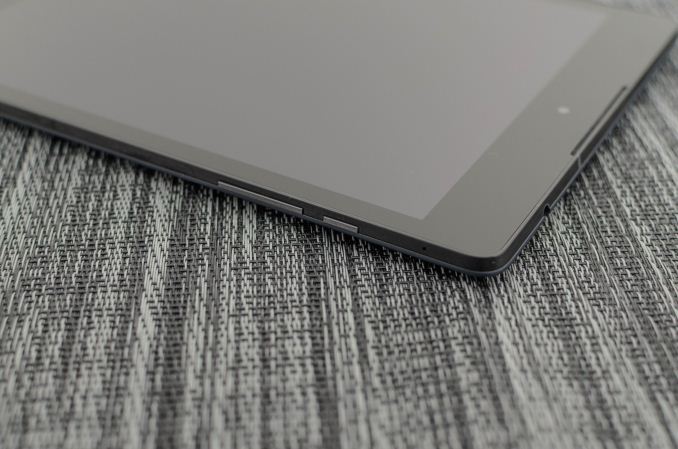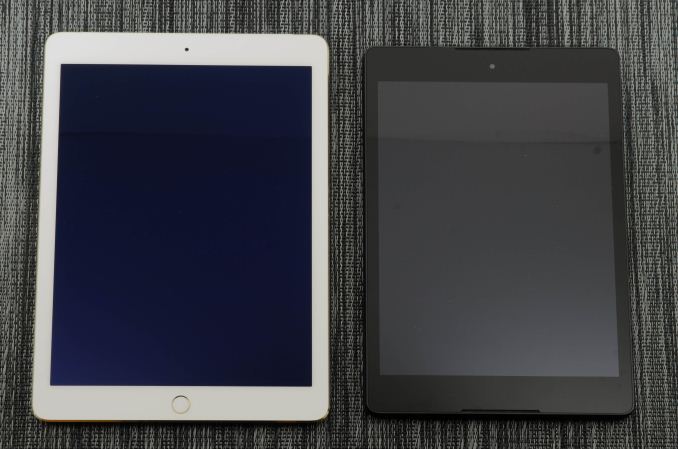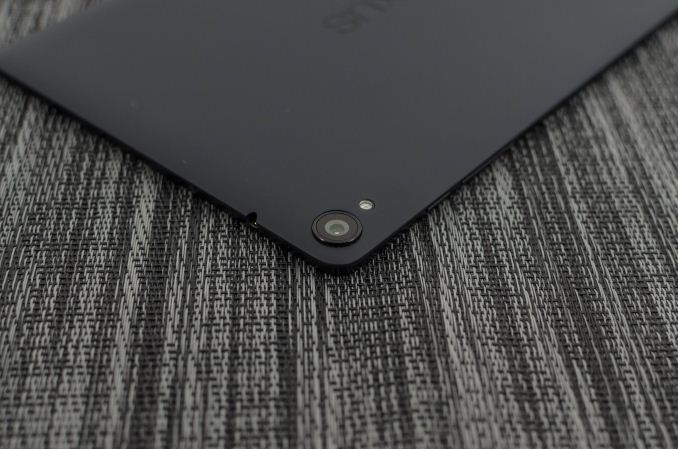The Google Nexus 9 Review
by Joshua Ho & Ryan Smith on February 4, 2015 8:00 AM EST- Posted in
- Tablets
- HTC
- Project Denver
- Android
- Mobile
- NVIDIA
- Nexus 9
- Lollipop
- Android 5.0
Final Words
The Nexus 9 is undoubtedly an aspirational device. For a long time now, Google and the Android tablet market in general have been in a position similar to Amazon’s Fire tablet. This has meant that the margin on the hardware itself has been quite low, and while quality was possible to achieve there were often sacrifices made in order to reach the targeted price point. This was seen in the form of lower CPU and GPU bins in the SoC, lower quality NAND, and generally poorer displays.
The Nexus 7 (2013) did manage to mostly avoid these issues, but Google had set the bar for price and performance to the point where OEMs would have issues with maintaining acceptable profit margins on a device. The Nexus 9 changes this strategy by reaching for a higher price point and attempting to deliver a no-compromise tablet in return. To figure out whether Google has succeeded, it’s worth going over each aspect of the device before coming to any sort of judgment.
The first and quite possibly most important aspect of the Nexus 9 is the SoC. To this end, the Nexus 9 is the very first Android device with AArch64 support enabled in Android. NVIDIA’s Tegra K1 with Denver is effectively the state of the art when it comes to SoCs in the Android OEM space, and no other device has launched with this SoC. While the fact that the SoC is built around the ARMv8 ISA is important, the architecture of the CPU itself is easily one of the most interesting designs we’ve seen in years. Unfortunately, while the design of the CPU is academically interesting it doesn’t seem that this produces real-world benefits. The Nexus 9 has one of the fastest SoCs we’ve seen to date, but this comes at the cost of worse power efficiency than the Cortex A15 version of the Tegra K1.
Another piece of the puzzle is the design, which is one of the key differentiators for a high-end mobile device. While one can debate the merits of various materials, it seems to be clear that an all-metal unibody chassis would’ve greatly improved the design of the Nexus 9 and justified its positioning better. While there is some level of give in the back cover, the buttons are quite thin and hard to find, and there’s a noticeable seam where the back cover and metal frame meet, the design isn’t actually all that bad in practice. Unfortunately, this seems to be a bit of a sore point as well for the Nexus 9 when compared against the iPad lineup.
While the SoC and design are often points of distinction for a premium tablet, the display is critical for any tablet. In this regard, the Nexus 9 does surprisingly well. With a 4:3 aspect ratio, high resolution, and high quality color calibration HTC and Google have outfitted the Nexus 9 with a great display. Unfortunately, there’s a great deal of variability present in these displays that presents itself in the form of backlight bleed along the edges of the display. While my unit only has a slight amount of bleed along the top edge of the device, other units can have more or less backlight bleed depending upon variance in production.
The one aspect that seems to be the product of a poor design choice is the high reflectivity of the display. Although I’m reasonably sure that the display is laminated due to the lack of an obvious gap between the display and glass, it seems that the optical material between the display and glass is poorly designed as I can see a distracting double reflection in the display. The Nexus 9 also compares unfavorably to the iPad Air 2 in this case as the anti-reflective coating on the iPad Air 2 is far superior to just about anything I’ve seen on the market.
Although I previously noted that the power efficiency of the SoC isn’t up to scratch, overall battery life is quite good on the Nexus 9. With a combination of a large battery and efficient display, Google and HTC have managed to compensate for the power consumption issues that come with Denver’s performance. Unfortunately, it seems that Kepler’s desktop-first design results in worse power efficiency than what we see on competing solutions such as the “GXA6850” found in competing SoCs. Even if this is compensated for by the ability to enable desktop-class gaming, the Nexus 9 doesn’t appear to support full OpenGL to begin with, unlike the SHIELD Tablet. This means that the extra capabilities enabled by the GPU are effectively wasted, which hurts the value proposition for the device overall. In light of the launch of the Tegra X1, I can't help but wonder how different the experience of the Nexus 9 would be with NVIDIA's latest SoC.
Outside of these primary elements of the tablet, there seems to be a reasonable level of attention to detail. The camera is acceptable, even if the focus and capture latency aren’t the greatest. The audio quality from the speakers is also quite good, and really helps to enable a great experience when watching any kind of video or listening to music without earbuds/headphones. The software experience is acceptable, although Google continues to fight issues with ecosystem support for tablets.
With all of this in mind, it’s hard to give a resounding recommendation of the Nexus 9. The Nexus 9 is a step towards a high-end Android tablet, but not the leap that Google was hoping for. If you want an Android tablet near the size of the Nexus 9, I can’t really recommend anything else. The Galaxy Tab S falls short on account of performance and battery life, and despite the somewhat unremarkable design of the Nexus 9 I believe that it is nicer than the Galaxy Tab S. However, if one were to assume that OEMs are currently readying devices to truly carry the torch of the high-end tablet, the Nexus 9 is a hard sell. I suspect that this wouldn’t be nearly as difficult if the Nexus 9 had a lower price point of $300 and $350 USD for the 16GB and 32 GB WiFi variants, and $450-$500 for the 32GB LTE variant. Google has managed to get close to the mark with the Nexus 9, but like the Nexus 6 it seems that it’s up to the OEMs to cover the remaining distance.














169 Comments
View All Comments
techcrazy - Friday, February 6, 2015 - link
Best Nexus 9 review i read. Excellent work anandtech team.RobilarOCN - Friday, February 6, 2015 - link
How does the Tab S fall short of the Nexus 9? I've owned both. Video playback battery life overwhelmingly supports the Tab S, it has a far superior screen (AMOLED...), It has a micro SD slot, it has the ability to connect to HDMI via MHL adapter. The only way the Nexus 9 can output video as it has no available adapter and no onboard MHL support is via 3rd party such as the Chromecast. The 16GB Nexus 9 and 16GB Tab S 8.4 are in the same price range but of course you can expand the memory on the Tab S via a micro SD card. The 32GB Nexus 9 sits in the same price range as the Tab S 10.1 and again the 10.1 can have cheap memory added to it.The only places the Nexus 9 wins is if you want a 4:3 format (and in that case the first gen IPad Air 64GB is cheaper and a better device) or if you absolutely have to have Lollipop which will eventually get to the Tab S.
UtilityMax - Sunday, February 8, 2015 - link
In my opinion Tab S will be eventually remembered as a flop. Yes, it has a great wide screen and good battery life for video playback. So it's great for watching videos, which is why I bought one (and would buy it again). Unfortunately, videos is the only thing that Tab S does truly well. The Tab S forums on the web are filled with discussions about "lag" and why Chrome can be so slow. For a flagship tablet, the CPU/GPU performance scores could have been a little better, and the standby as well as web browsing battery life could be A LOT better. The other day I was stuck in a library for hours with this tablet and came to realization that I am not sure if this thing can last for 5 hours of web browsing on a full battery charge, which is horrendous. I have a Samsung laptop with a quad core i7 CPU and 17 inch screen that could work longer on a battery charge.Basically, this tablet gives you a great screen, SD card slot, good build quality, and not much else. I am still glad I got a 10.5 Tab S on a sale for $400. However, I don't think it's really worth the "regular" price of +500 dollars.
Impulses - Monday, February 9, 2015 - link
5 hours? Yikes... My Atom netbook from half a decade ago could manage that...UtilityMax - Sunday, February 15, 2015 - link
But amazingly, the Tab S 10.5 can play a 720p video for something like 10 hours on a full charge. Go figure.mkozakewich - Friday, February 6, 2015 - link
Those NVidia charts obviously show the IPC measured in a 'ratio'. They're not going to tell us what exact IPC they get.So yeah, the highest it goes is less than 2.0, which means their IPC for optimized code isn't quite double the performance of regular ARM stuff. I'd suppose the regular code could get up to 3 IPC, which means the optimized stuff could get up to 6 IPC (out of the maximum 7). It seems to check out.
I'd have expected you not to throw caution to the wind when reading first-party benchmark slides.
flamingspartan3 - Friday, February 6, 2015 - link
The Nexus 7 2013 is still competitive in many of these benchmarks. It's remarkable how great the device is even after almost two years.UtilityMax - Sunday, February 8, 2015 - link
The criticism that there aren't enough apps for the big screen is somewhat misplaced. I suspect that web browsing, videos, ebooks, and productivity apps are the prime applications for the large screen tablets. Why bother with the facebook app, when you can just login into facebook from chrome, and with the biggish screen have access to the full facebook web site?Impulses - Monday, February 9, 2015 - link
Chrome alone probably accounts for like 80% of my tablet use (and I've had an Android tablet since the OG TF) seems that's not necessarily the norm tho...Jumangi - Monday, February 9, 2015 - link
Then why pay for a device with such high end components like the K1 SoC if your just gonna use the browser? Maybe this is what some do because the android marketplace is so limited for large tablet apps but doesn't mean its ok.